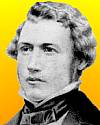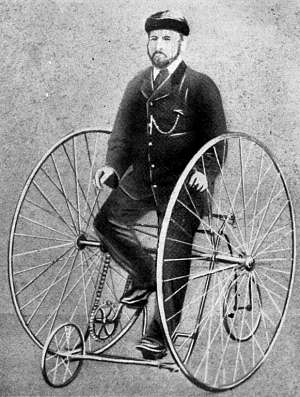
|
James Starley
(21 Apr 1830 - 17 Jun 1881)
British inventor and manufacturer.
|
The Late James Starley.
from Wheel World (1881)
 James Starley on his 'Salvo' tricycle, the first machine to which his differential gear was fitted, 1877.
James Starley on his 'Salvo' tricycle, the first machine to which his differential gear was fitted, 1877.[p.116] THE death of Mr. James Starley, which occurred on the evening of June 17th, deprives us of one of the greatest lights the wheel trade and its supporters have ever known. Quiet, genial and unobtrusive, Mr. Starley— “the old man,” as he was endearingly termed throughout the trade—worked steadily onwards in the great work of his life, gaining friends on all sides wherever he went, and earning for himself a name to be envied by all who desire true greatness.
Throughout his life he worked not for himself, but most for others’ good, his generous saying, “The world is a large place and there is room enough for all,” coming with expressive force from the lips of a man who envied no one, possessed no trade jealousy, and was ever willing to assist beginners in the trade, or any one else who needed his help. To him the tricycle trade and pastime owes its very existence, and the bicycle trade and bicyclists in general are mainly indebted to him for their present prosperous condition. Entirely self-made, he rose from the humble position of a farm lad to that of a prosperous manufacturer, and lived to see the trade of a city resuscitated by his exertions, which have been the means of mainly creating a trade now supporting its thousands of workpeople, with their families and the numerous other classes dependent upon their support.
He was born at the pretty little village of Albourne, in Sussex, and received no better education than could be obtained at a National school, which he attended about two years. He was taken from school at the early age of nine years to work on the farm occupied by his father, Daniel Starley. About the year 1846 or 1847, he said that the occupation did not suit him, and that he should go to London, as it was his opinion there would be a better future for him there than in working on a farm. He walked from Sussex into Kent, and finally settled in Lewisham, where he married, and was some years under the late Mr. Penn as under gardener. It was here his mechanical genius first developed itself.
He invented the adjustable candlestick, the one stringed window blind, and the magic bassinette (which, said the advertisement of that date, would soothe and lull the most tiresome of infants), this being a mechanical contrivance to rock the cradle. About 1855 he left Lewisham, and turned his attention to improving sewing machines, under Mr. Newton Wilson, 144, High Holborn, where he stayed about two years, and then came to Coventry, bringing with him his first sewing machine invention, “The European.” He was engaged as managing foreman by the Coventry Machinists’ Company, which was formed for the purpose of manufacturing this machine, and also with the praiseworthy object of finding employment for the followers of the watch trade, who were then suffering from the great depression. In these years, Mr. Starley invented and patented [p.117] many different kinds of sewing machines; indeed, it may safely be affirmed that the larger number of the machines now in the market embody the results of his inventions.
His connection with the bicycle industry commenced twelve or
fourteen years ago. About that time a French bicycle was introduced to
the city by Mr. R. Turner, a nephew of the manager of the Machinists’
Company, and the Machinists’ Company took up the manufacture. This
opened up an entirely new field, and Mr. Starley was one of others who
invented and applied improvements to the cumbrous wooden machines of
that day. His first invention was the bicycle known as “The ‘C’ Spring
and Step Machine, or The Coventry Model.” The superiority of this
machine was evident to the most uninitiated, the curved spring, small
hind-wheel, and the step for mounting, being the principal
improvements. The “Ariel” bicycle, which took the public fancy to such
a great extent, speedily followed. This machine was fitted with pivot
centre steering, being the first bicycle to which this improvement was
applied. From that time Mr. Starley’s inventions, and improvements and
applications of known principles, followed each other in rapid
succession.
After inventing the “Ariel,” Mr. Starley left the employment of the Machinists’ Company, and started for himself in St. John Street, where he manufactured “Ariel” bicycles and sewing machines, and while there he brought out the well-known “Europa” sewing machine. After having overcome considerable difficulties, he subsequently went into partnership, and the firm of Messrs. Smith, Starley, and Co., was launched at the St. Agnes Works, St. Agnes Lane, the chief employment of the firm consisting in the manufacture of “Ariel” bicycles and “Europa” sewing machines. After carrying on this business for some time, the firm disposed of the bicycle manufacturing portion of their trade to Messrs. Haynes and Jefferis, including the whole of the “Ariel” patents. Still pursuing his natural proclivities Mr. Starley shortly introduced the “Tangent” machine, which became very popular; and in two or three years afterwards he brought out the “Coventry Tricycle,” both machines being manufactured by Messrs. Haynes and Jefferis, the inventor still carrying on the sewing machine business.
From St. Agnes Works Messrs. Smith, Starley, and Co. removed to Trafalgar Works, but their stay there was only a brief one, owing to business difficulties. Mr. Starley then for some time carried on the work of making “Tangent” wheels for Messrs. Haynes and Jefferis, and while so employed his inventive faculties were kept in full work, and as the result the “Salvo quadricycle” made its appearance. This undoubtedly was his masterpiece, and from time to time it underwent improvements, until it assumed that perfection which commended it to Royalty in the early part of this year.
Mr. Starley’s unpatented inventions and improvements were if possible of more value than those which he protected. He invented the double-throw crank, and the chain and chain wheels to obtain rotary motion in tricycles; and the rack and pinion steering [p.118] gear was his application to the same machines. Possibly hundreds of other details in the construction of the various machines were due to him. His original ideas and suggestions were from the commencement of the bicycle industry of incomputable value, and it is probable that, but for his perseverance, Coventry would never have been the centre of so great, important and increasing an industry. The bicycle was established and improved by him, and of the tricycle he was without doubt the inventor, pressing quietly onward with the ideas that presented themselves to his fertile brain, notwithstanding the laughter and ridicule which in some quarters were heaped upon him.
The results of his exertions will live long after his removal, and
when the bicycle and tricycle industry has passed from infancy to
maturity the name of James Starley will be remembered as that of the
man who was chiefly instrumental in establishing it in this country.
 21 April - short
biography, births, deaths
and events on date of Starley's birth.
21 April - short
biography, births, deaths
and events on date of Starley's birth.





